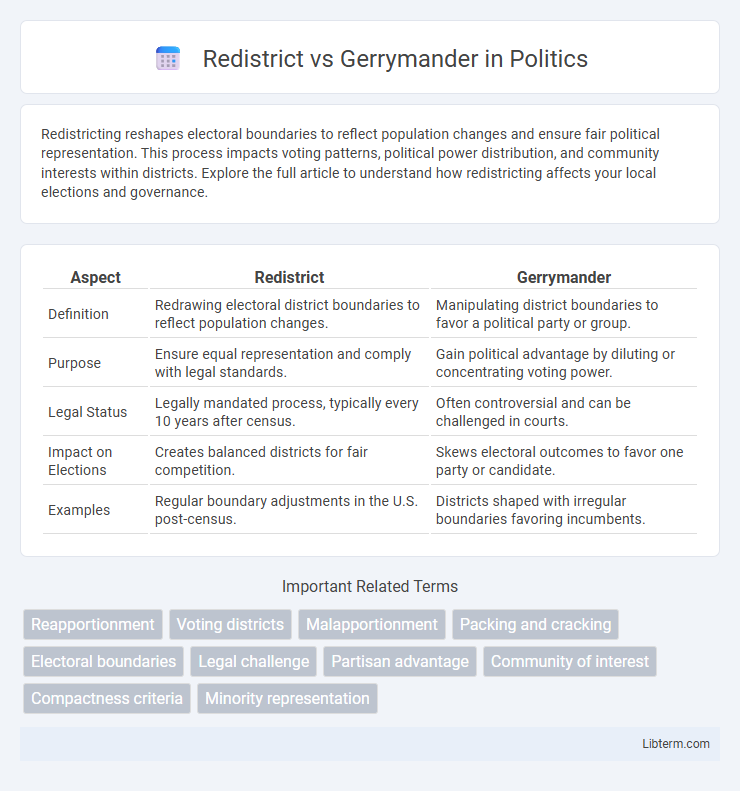Redistricting reshapes electoral boundaries to reflect population changes and ensure fair political representation. This process impacts voting patterns, political power distribution, and community interests within districts. Explore the full article to understand how redistricting affects your local elections and governance.
Table of Comparison
| Aspect | Redistrict | Gerrymander |
|---|---|---|
| Definition | Redrawing electoral district boundaries to reflect population changes. | Manipulating district boundaries to favor a political party or group. |
| Purpose | Ensure equal representation and comply with legal standards. | Gain political advantage by diluting or concentrating voting power. |
| Legal Status | Legally mandated process, typically every 10 years after census. | Often controversial and can be challenged in courts. |
| Impact on Elections | Creates balanced districts for fair competition. | Skews electoral outcomes to favor one party or candidate. |
| Examples | Regular boundary adjustments in the U.S. post-census. | Districts shaped with irregular boundaries favoring incumbents. |
Understanding Redistricting: Definition and Purpose
Redistricting is the process of redrawing electoral district boundaries to reflect population changes identified in the decennial census, ensuring equal representation in legislative bodies. It aims to balance districts based on population shifts to uphold the principle of "one person, one vote." Unlike gerrymandering, which manipulates boundaries for political advantage, redistricting serves the fundamental purpose of fair and effective representation.
The Origins and Evolution of Gerrymandering
Gerrymandering originated in 1812 when Massachusetts Governor Elbridge Gerry approved a redistricting plan favoring his party, creating oddly shaped districts that manipulated electoral outcomes. Over time, gerrymandering evolved from simple partisan advantages to sophisticated strategies using advanced data analytics and geographic information systems (GIS) to maximize political gain. This manipulation contrasts with legitimate redistricting, which aims to fairly represent populations based on census data and legal guidelines.
Legal Frameworks: How Redistricting is Governed
Redistricting is governed by a combination of federal laws such as the Voting Rights Act and constitutional principles like equal population distribution outlined in the "one person, one vote" doctrine. Legal frameworks require that electoral district boundaries be redrawn every ten years based on census data to ensure fair and equal representation. Gerrymandering occurs when these legal standards are manipulated to favor a particular party or group, often resulting in court challenges to enforce compliance with anti-discrimination and fairness mandates.
Redistricting vs Gerrymandering: Key Differences
Redistricting is the legal process of redrawing electoral district boundaries based on population changes following the census, ensuring equal representation. Gerrymandering manipulates these boundaries intentionally to favor a particular political party or group, undermining fair representation. Key differences lie in redistricting's goal of equal population distribution, while gerrymandering prioritizes political advantage through tactics like packing and cracking voters.
The Impacts of Gerrymandering on Electoral Fairness
Gerrymandering significantly undermines electoral fairness by manipulating district boundaries to favor specific political parties, often diluting the voting power of opposing groups. This practice skews representation in legislative bodies, resulting in outcomes that do not accurately reflect voter preferences or demographics. Studies reveal that gerrymandered districts contribute to decreased electoral competitiveness and reduced voter engagement, eroding the foundational principles of democratic representation.
Tools and Techniques Used in Redistricting
Redistricting employs geographic information systems (GIS) and demographic data analysis to create balanced electoral districts based on population equality and legal requirements. Advanced mapping software enables transparency and public input, ensuring fair representation without intentional bias. These tools contrast with gerrymandering techniques that manipulate boundaries to favor specific political interests.
Notable Cases of Gerrymandering in History
Gerrymandering, the manipulation of electoral district boundaries to favor a political party, has been notably exemplified in cases such as the 1812 Massachusetts district designed by Governor Elbridge Gerry, which gave rise to the term "gerrymander." The 2010 redistricting in North Carolina was heavily litigated due to allegations of racial and partisan gerrymandering, resulting in court-ordered map redraws. Another significant case is the 2018 Pennsylvania Supreme Court ruling that invalidated the state's congressional map for extreme partisan gerrymandering, emphasizing the impact of biased redistricting on electoral fairness.
Redistricting Reform: Solutions and Proposals
Redistricting reform aims to establish independent commissions that eliminate partisan bias and ensure fair electoral boundaries, promoting equal representation. Proposals include clear, transparent criteria such as compactness, community preservation, and competitiveness to replace arbitrary or politically motivated district drawing. Implementing these solutions can reduce gerrymandering's impact and enhance democratic integrity by ensuring each vote carries equal weight.
The Role of Technology in Modern Redistricting
Technology plays a crucial role in modern redistricting by enabling precise mapping based on demographic data, voting patterns, and geographic information systems (GIS). Advanced algorithms and data analytics facilitate the creation of districts that can either promote fair representation or be manipulated to gerrymander for partisan advantage. The availability of comprehensive data sets and powerful software tools has transformed redistricting into a highly technical process, impacting political outcomes significantly.
Protecting Democracy: Ensuring Fair Representation
Redistricting involves redrawing electoral district boundaries based on population changes to ensure equal representation, while gerrymandering manipulates these boundaries to favor a particular party or group, undermining democratic principles. Protecting democracy requires transparent, non-partisan redistricting processes that uphold fairness and prevent disproportional influence or voter disenfranchisement. Fair representation through unbiased district maps strengthens electoral integrity and enhances public trust in democratic institutions.
Redistrict Infographic

 libterm.com
libterm.com